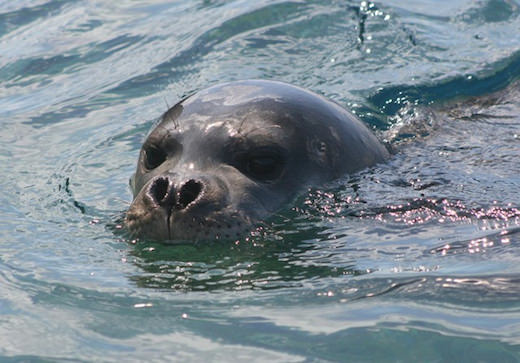Mediterranean Monk Seal

Critically endangered
The Mediterranean monk seal is believed to have the shortest hair of any aquatic mammal and is also one of the world's most critically endangered. Broad snouted and dark brown to black in appearance with a much lighter underside, the Mediterranean monk seal is also equipped with two pairs of retractable abdominal teats and noticeably short flippers and claws. Moreover, unlike today Mediterranean monk seals were once regarded as calm and trusting creatures to the extent that in Greek tradition a Mediterranean monk seal sighting was considered a good omen for seafarers due to the animal's apparent love for the sea and sun.
Feeding on fish and mollusks, Mediterranean monk seals consume approximately 3kg of food each day and are known to dive to and forage for food at depths of up to 230 feet. Fast and agile, the Mediterranean monk seal prefers to hunt and forage in open spaces and is also what is known as a bottom feeder in that it will on occasion scour the seabed in search of food. In fact, Mediterranean monk seals have both been recorded at dive levels of up to 500 feet and engaged in the behaviour of lifting rocks on the seabed in search of food.
Presently rearing their young in inaccessible caves which are usually only accessible via underwater entrances, Mediterranean monk seal pups are about a meter long and first enter water two weeks after being born and weaned.
Population Distribution
During the classical era, the Mediterranean monk seal was common in the Mediterranean. It bred, rested and weaned its young on Mediterranean beaches and was known to venture as far south as Mauritania, Senegal and the Gambia on Africa's Atlantic coast. Presently however, Mediterranean monk seal sightings only occur at two locations. One of these is Cabo Blanco in the Atlantic Ocean and the other is in the Agean Sea. Not only however, has the Mediterranean monk seal declined over the last century especially, but its behavior has changed drastically in that the species purposefully uses dangerous and hard to reach caves and areas of coastline in order to congregate and breed free of human contact.
Threats
Believed to number just 600, the Mediterranean monk seal is threatened by poor genetic diversity, significant susceptibility to disease and with being located in just two small areas, significant susceptibility to local catastrophes. In fact in 1997 the Mediterranean monk seal population at Cabo Blanco experienced a full two thirds population die off due to what it is believed was exposure to either a virus or toxic algae bloom.
However, habitat loss due to heavy coastal development is also a significant threat. Indeed, Mediterranean monk seal infant mortality usually arises directly as a result of the Mediterranean monk seal attempting to birth, wean and rear young in dangerous underwater cave and rocky shore environments which it has been pushed to due to development encroachment almost all other coastal sites.
Likewise, decreased food availability due to over fishing, entanglement in fishing nets and deliberate killing by fishermen who see the Mediterranean monk seal as a pest are all leading factors in the species' continued decline.